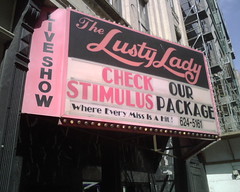 Image by drocksays via Flickr
Image by drocksays via FlickrOne popular housing theory is that -- before a bona fide housing recovery can begin -- the cost of owning a home versus renting one must return to historical levels.
If that belief is a truth, a national return to rising home prices may be in store for 2009.
Falling home prices coupled with falling mortgage rates, too, have dropped the relative, after-tax cost of owning a home to 125% of the cost of renting a home.
This is the exact 18-year historical average and not since 2001 has the gap been this small.
As reported by the Wall Street Journal, though, the study has some flaws. For example, the data doesn't account for ongoing home maintenance costs, nor does it consider real estate tax bills and insurance policies.
But, combining a relatively low cost of ownership with the government's $8,000 tax credit for first-time home buyers is likely to convert long-time renters into never-before homeowners.
This, too, is thought to be a key element of the housing recovery.
In Philadelphia, typically the cost of owning has been very close to the cost of owning, and that fact, combined with the tax benefits of home ownership, and the financial stability of our housing market, has always tilted the scales in favor of owning a home. While our market has demonstrated remarkable price stability in light if the current economic issues, in many other markets (but not all), home prices are expected to edge lower through 2009. Provided mortgage rates stay low, the cost gap between owning and renting will shrink even more.
(Image courtesy: Wall Street Journal)
![Reblog this post [with Zemanta]](http://img.zemanta.com/reblog_e.png?x-id=eb764ee9-1a7b-4bd3-8ac8-0146c545a4c8)

![Reblog this post [with Zemanta]](http://img.zemanta.com/reblog_e.png?x-id=a10ef2c9-60e0-4413-a0ec-8df4ca034f75)

![Reblog this post [with Zemanta]](http://img.zemanta.com/reblog_e.png?x-id=658ac1f9-7b3f-4219-b86a-c9b908386aff)

 Last Friday, Fannie Mae rolled-back one of its least popular mortgage guidelines updates of the last 12 months.
Last Friday, Fannie Mae rolled-back one of its least popular mortgage guidelines updates of the last 12 months. ![Reblog this post [with Zemanta]](http://img.zemanta.com/reblog_e.png?x-id=df856762-45ae-4c6a-93df-7f4a87a1a871)

 With Congress reaching agreement on a
With Congress reaching agreement on a ![Reblog this post [with Zemanta]](http://img.zemanta.com/reblog_e.png?x-id=dec40b65-6bca-435d-abed-11210aea1010)

![Reblog this post [with Zemanta]](http://img.zemanta.com/reblog_e.png?x-id=1949c178-ddea-41b5-9b95-cbb2ae680d93)

![Reblog this post [with Zemanta]](http://img.zemanta.com/reblog_e.png?x-id=9903579a-0f1b-4dd9-995d-644b8c839bbc)

![Reblog this post [with Zemanta]](http://img.zemanta.com/reblog_e.png?x-id=98fb6e41-6010-49ac-8124-db8a2e85c6b2)

![Reblog this post [with Zemanta]](http://img.zemanta.com/reblog_e.png?x-id=f9d14684-d216-44da-ae47-d2ec7a2bc48d)
![Reblog this post [with Zemanta]](http://img.zemanta.com/reblog_e.png?x-id=2c96ab53-2aa8-4ce3-8028-b418aa928f25)

